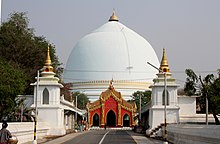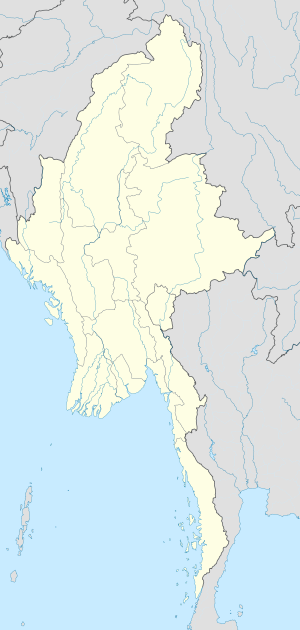Kaunghmudaw Pagoda
| Yaza Mani Sula Kaunghmudaw ရာဇမဏိစူဠာ ကောင်းမှုတော် Rājamaṇicūḷā |
|
|---|---|
 |
|
| Basic information | |
| Geographic coordinates | 21°55′57.92″N 95°56′16.63″E / 21.9327556°N 95.9379528°ECoordinates: 21°55′57.92″N 95°56′16.63″E / 21.9327556°N 95.9379528°E |
| Affiliation | Theravada Buddhism |
| Country | Myanmar |
| Architectural description | |
| Founder | Thalun |
| Completed | 23 July 1636 12 May 1648 (completed) |
The Kaunghmudaw Pagoda (Burmese: ကောင်းမှုတော် ဘုရား [káʊɴ m̥ṵ dɔ́ pʰəjá]; Yaza Mani Sula Kaunghmudaw (ရာဇမဏိစူဠာ ကောင်းမှုတော်); Pali: Rājamaṇicūḷā) is a large pagoda on the northwestern outskirts of Sagaing in central Myanmar (Burma). Modeled after the Ruwanwelisaya pagoda of Sri Lanka, the Kaunghmudaw is known for its egg-shaped design, which stands out among more traditional-style, pyramid-shaped Burmese pagodas. The stupa's formal name Yaza Mani Sula signifies the enshrinement of Buddhist relics inside its relic chamber. But it is commonly known by its popular name, Kaunghmudaw (lit. "Royal Merit-Making"). It is an important pilgrimage and tourist destination in the Sagaing area.
Construction began during the reign of King Thalun on 25 April 1636 (Friday, 8th waning of Kason 998 ME). The pagoda's relic chamber was dedicated on 23 July 1636 (Wednesday, 7th waning of 2nd Waso 998). The pagoda was completed 12 years later on 12 May 1648 (Tuesday, 6th waning of Kason 1010) towards the end of Thalun's reign.
The pagoda is 46 metres (151 ft) high and has a circumference of 274 meters. The hti (umbrella or crowning) of the pagoda is 7.92 metres (26.0 ft) high and weighs 3.5 kilograms (7.7 lb) (3440 viss). The pagoda differs from the traditional Burmese-style pyramidal structures by having an arched image chamber in the center of its base. The chamber houses a massive seated 7.3 metres (24 ft)-high Buddha statue, carved out of solid white marble. The head of the Buddha statue alone is about 2.4 meters in diameter. It is believed that the dome was built later around the massive statue.
The lowest terrace of the pagoda is decorated with 120 nats and devas. It is ringed by 802 stone lanterns, carved with inscriptions of Buddha's life in three languages: Burmese, Mon and Shan Yuan, representing the three main regions of Restored Toungoo Kingdom.
...
Wikipedia

